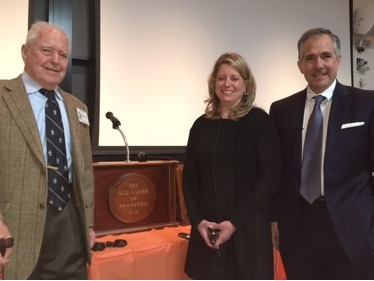March 8, 2017
Heroin and Hepatitis C:
A Major Problem for the USA and New Jersey
Ronald G. Nahass, M.D., and Kathleen Seneca, APN
Infectious Disease Medicine
Minutes of the 23rd Meeting of the 75th Year
The March 8 meeting was called to order by President Jock McFarlane at 10:15 a.m. There were 83 attendees. Roland Foster Miller led the invocation. Diana Crane introduced her husband and guest, Giles Crane. The minutes of the March 1, 2017, meeting were read by Roland Foster Miller. The speakers were introduced by Harvey Rothberg.
Dr. Nahass began by stating that “heroin addiction is a tragic problem for both the U.S.A. and New Jersey.” In recent years there has been a dramatic increase in heroin-related deaths, with the New Jersey rate being 2.5 times the national death rate. The mean age when heroin is started in New Jersey is 24½. The greatest death rate is in the less than 35-year-old group, and the largest increase in heroin use in New Jersey is seen in rural areas. Heroin death rates are higher than death rates caused by accidents.
The discussion then turned to the epidemic of Hepatitis C which is directly related to heroin use. Ms. Seneca described six different Hepatitis C genotypes, all of which can be treated and cured by a single medication. Barriers to patient follow-up include high socioeconomic instability, transportation issues, legal involvement and insurance limitations. Both Ms. Seneca and Dr. Nahass emphasized the need to treat both the heroin addiction and Hepatitis C. Without adequate treatment of heroin addiction, Hepatitis C relapse rates will be high. Pharmacologic counseling, family support and the use of community services are all very important. Dr. Nahass’s sense of frustration was apparent in relation to what he felt was very poor coordination among governmental health agencies.
Data and epidemiology of HIV/AIDS and Hepatitis C seem to be very similar. For that reason, Dr. Nahass felt that the successful management of HIV can be used as a model for Hepatitis C treatment.
The Q&A session illuminated the very high cost of Hepatitis C drug therapy, possibly exceeding $90,000 -- which may not be covered by insurance -- and the increased risk of liver cancer and cirrhosis in patients with chronic Hepatitis C.
Respectfully submitted,
Seth Malin
Dr. Nahass began by stating that “heroin addiction is a tragic problem for both the U.S.A. and New Jersey.” In recent years there has been a dramatic increase in heroin-related deaths, with the New Jersey rate being 2.5 times the national death rate. The mean age when heroin is started in New Jersey is 24½. The greatest death rate is in the less than 35-year-old group, and the largest increase in heroin use in New Jersey is seen in rural areas. Heroin death rates are higher than death rates caused by accidents.
The discussion then turned to the epidemic of Hepatitis C which is directly related to heroin use. Ms. Seneca described six different Hepatitis C genotypes, all of which can be treated and cured by a single medication. Barriers to patient follow-up include high socioeconomic instability, transportation issues, legal involvement and insurance limitations. Both Ms. Seneca and Dr. Nahass emphasized the need to treat both the heroin addiction and Hepatitis C. Without adequate treatment of heroin addiction, Hepatitis C relapse rates will be high. Pharmacologic counseling, family support and the use of community services are all very important. Dr. Nahass’s sense of frustration was apparent in relation to what he felt was very poor coordination among governmental health agencies.
Data and epidemiology of HIV/AIDS and Hepatitis C seem to be very similar. For that reason, Dr. Nahass felt that the successful management of HIV can be used as a model for Hepatitis C treatment.
The Q&A session illuminated the very high cost of Hepatitis C drug therapy, possibly exceeding $90,000 -- which may not be covered by insurance -- and the increased risk of liver cancer and cirrhosis in patients with chronic Hepatitis C.
Respectfully submitted,
Seth Malin

